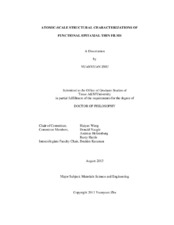| dc.contributor.advisor | Wang, Haiyan | |
| dc.creator | Zhu, Yuanyuan | |
| dc.date.accessioned | 2013-12-16T19:56:13Z | |
| dc.date.available | 2015-08-01T05:48:32Z | |
| dc.date.created | 2013-08 | |
| dc.date.issued | 2013-06-03 | |
| dc.date.submitted | August 2013 | |
| dc.identifier.uri | https://hdl.handle.net/1969.1/150965 | |
| dc.description.abstract | A precise understanding of the fundamental correlation between synthesis, microstructure and physical properties is of vital importance towards rational design of improved functional epitaxial thin films. With the presence of heterogeneous interface and associated inhomogeneous lattice strain, film microstructure becomes sensitive to subtle interfacial perturbations and hence may exhibit intriguing physical properties. Control of the epitaxial film functionality requires accurate knowledge of the actual film chemistry, interfacial defects and associated strain field.
This dissertation reports in-depth microstructural characterization of the intrinsic chemical inhomogeneity in selected epitaxial thin films including superconducting Fe1+yTe1-xSex/SrTiO3(STO) heterogeneous systems, the flux-pinning defects at both of conversional YBa2Cu3O7-δ (YBCO)/substrate lateral interfaces and vertical interfaces of YBCO&BaSnO3(BSO) nanocomposite films, and the misfit dislocation core configurations of STO/MgO and MgO/STO heterostructures pair, using the state-of-the-art aberration-corrected scanning transmission electron microscopy (CS-corrected STEM) in combination with geometric phase analysis (GPA).
For the first time, the local atomic arrangement of Te and Se as well as interstitial Fe(2) has been clearly revealed in superconducting Fe1+yTe1-xSex/STO epitaxial films. We found that the film growth atmosphere can greatly affect the film stoichiometry, the homogeneity of Se/Te ordering and thus the overall film superconductivity.
YBCO/substrate interface mismatch and YBCO&BSO vertical interface contact have been explored through substrate selection and doping-concentration variation. We observed a diverse nature of intrinsic defects in different YBCO/substrate heterosystems; thermal stable defects capable of maintaining individual strain field have been found effective in flux-pinning. Along the vertical heterointerface of YBCO/BSO, misfit dislocations were found throughout the film thickness. It adds another dimension to the flux-pinning landscape design.
Four basic misfit dislocation core configurations of a STO/MgO heterosystem have been identified, and found strongly dependent on the actual interface disordering such as substrate atomic-height steps and interdiffussion. To precisely quantify the heterointerface lattice strain, we first conducted systematic investigations on the accuracy of STEM-based GPA. Follow our protocol, 1 pm accuracy has been proven in the STEM fast-scan direction with a spatial resolution less than 1 nm. The effectiveness and reliability of this optimized GPA strain profile were demonstrated in both applications of a relaxed STO/MgO and a partially strained LaAlO3/STO heterointerfaces, respectively. | en |
| dc.format.mimetype | application/pdf | |
| dc.language.iso | en | |
| dc.subject | epitaxial thin films | en |
| dc.subject | misfit dislocations | en |
| dc.subject | interface defects | en |
| dc.subject | lattice strain | en |
| dc.subject | aberration-corrected scanning transmission electron microscopy | en |
| dc.subject | geometric phase analysis. | en |
| dc.title | Atomic-scale Structural Characterizations of Functional Epitaxial Thin Films | en |
| dc.type | Thesis | en |
| thesis.degree.department | Electrical and Computer Engineering | en |
| thesis.degree.discipline | Materials Science and Engineering | en |
| thesis.degree.grantor | Texas A & M University | en |
| thesis.degree.name | Doctor of Philosophy | en |
| thesis.degree.level | Doctoral | en |
| dc.contributor.committeeMember | Naugle, Donald | |
| dc.contributor.committeeMember | Holzenburg, Andreas | |
| dc.contributor.committeeMember | Harris, Rusty | |
| dc.type.material | text | en |
| dc.date.updated | 2013-12-16T19:56:13Z | |
| local.embargo.terms | 2015-08-01 | |


